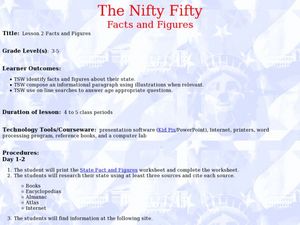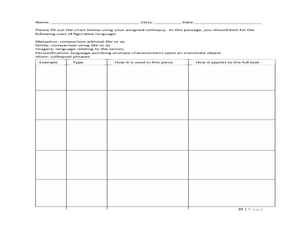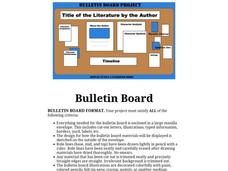Curated OER
Coming Home:From the Life of Langston Hughes
Third graders listen to the non-fiction book: COMING HOME: FROM THE LIFE OF LANGSTON HUGHES. They identify examples of metaphors and similies within the book and understand how this figure of speech is used in writing. They then create...
Curated OER
Memory & Song, Malagan Figures from New Ireland, Papua New Guinea
Students investigate the uses of images, shapes and colors in classic art sculptures. In this art analysis lesson plan, students observe Malagan Figures, a type of sculpture from New Guinea, and describe the different ideas and images...
Curated OER
Using Personification
Young readers listen to the story The Three Little Pigs, and discuss what abnormal characteristics the pigs and the wolf have. They relate these characteristics to personification, and practice writing sentences using personification.
Curated OER
The Nifty Fifty- Facts and Figures
Students explore an assigned state. In this United States geography lesson, students identify facts and figures related to a particular state. Students use the Internet for research and create a PowerPoint presentation displaying these...
Curated OER
Figuratively Speaking
In this Language Arts learning exercise, students read 5 sentences and match them to a more figurative phrase. Students write the phrases below each sentence.
Curated OER
Chapter 9: Language Processing: Humans and Computers
Designed to accompany An Introduction to Language by Victoria Fromkin, Robert Rodman, and Nina Hyams, this powerpoint addresses a number of language, technological, and sociological topics. The slides could be helpful in either a...
Curated OER
Logs, Charts, and Journals: What's On Your Plate?
Have your writers identify and use words that appeal to the senses. They create a chart of sensory words and record some of their favorites, then write a journal entry in which they describe eating at a restaurant using sensory details....
Curated OER
Headless Horseman, Heady Author
Twelfth graders explore figurative language as it appears in Washington Irving's original text, The Legend of Sleepy Hollow, answer questions based on story, and write sequels to it by using the different types of figurative language...
Curated OER
Blanket the Plains
Learners discuss vivid imagery in a story. In this figurative language lesson plan, students read samples of sensory language and then discuss the meaning of a piece of figurative language. Learners provide examples.
Curated OER
Soliloquy Performances
Learners investigate soliloquies. In this performing arts lesson, students discuss figurative language within soliloquies and then perform a soliloquy to the rest of the class.
Curated OER
Language Arts: Stylistic Devices
Students are able to define given literary terms, such as metaphor, simile, imagery, personification, symbolism, etc. They are able to identify the use of literary elements in a given text. Students are able to interpret weather...
Curated OER
Poetry, Take Me Away!
Students explore a variety of poetry and poetry concepts. They examine figurative language, mood, and literary devices. The students write and recite their own poetry.
K12 Reader
Alliteration Animals
Bees buzz, dogs dig, lion laze, and snakes slither! Use alliteration to create sentences about four different animals.
EngageNY
Poetic Tools in Narrative of the Life of Frederick Douglass
Scholars listen to a reading and answer probing questions about If We Must Die by Claude McKay. Readers annotate their personal copies of the poem as they discuss its figurative language, vocabulary, and meaning. They then transfer their...
National Endowment for the Humanities
Language Analysis Based on Stave 1
Class members meet the original scrooge, the Dickens character whose name has become synonymous with a cold-hearted, tight-fisted, miser. Using the provided worksheet, readers closely examine context clues to determine the meanings of...
Poetry4kids
How to Write an Alliteration Poem
Learners follow five steps to compose an alliteration poem. They choose one consonant and brainstorm as many nouns, verbs, and adjectives they can think of to create rhyming sentences that come together in a poetic fashion.
Curated OER
Charles Darwin Meets John Paul II
If you teach AP English language and composition and are looking for a way to address the differences between written and spoken arguments, consider this lesson. Over the course of three days, class members research Charles Darwin or...
Museum of Disability
A Picture Book of Helen Keller
Teach your class about Helen Keller and her accomplishments with a reading comprehension lesson based on A Picture Book of Helen Keller by David A. Adler. As individuals read, they answer discussion questions about Helen Keller and the...
abcteach
Dragon Alliterations
You don't have to slay the dragon in this activity. Young writers review poetic devices with a set of worksheets about alliteration and similes. Once they finish waxing poetic about their dragon friends, they craft a final acrostic poem.
University of North Carolina
Clichés
When it comes to writing, cliches are as old as dirt. A handout on tired phrases provides examples of cliches, as well as a description of the negative effects they have on a paper. Writers discover specific words and phrases to avoid,...
Helena-West Helena School District
I Know Why the Caged Bird Sings Instructional Unit Plan
Maya Angelou's first autobiography, I Know Why the Caged Bird Sings, demonstrates both the author's exemplary writing and the themes of gender and racial injustice that perpetuate beyond the limits of the 20th century. Use a thorough...
Curated OER
Genre Lesson: Poetry
Hook kids into a study on poetry elements by asking them to bring in the lyrics to their favorite song. Discuss the elements in one or two songs (preferably that demonstrate rhyme, figurative language, or a repeating phrase). Groups do...
Sandra Effinger
Bulletin Board Project
Imagine a project that informs and entertains. Replace book reports with a bulletin board that highlights all the important elements of a novel. Readers research the author, create a timeline of events in the story, write a character...
College of New Rochelle
Latin Worksheet: Horace, Ode 1.5
Take a look at Horace's "Ode 1.5" from Carmina in depth with an analysis worksheet. Included on the first page is the original Latin version of the verses as well as a literal translation. Pupils respond to questions relating to sounds,...
Other popular searches
- Figurative Language Poetry
- Figurative Language in Poems
- Figurative Language Quiz
- Figurative Language Project
- Imagery Figurative Language
- Figurative Language Lessons
- Using Figurative Language
- Figurative Language Worksheets
- Figurative Language Test
- Figurative Language in Poetry
- Figurative Language Vocabulary
- Figurative Language in Prose

























